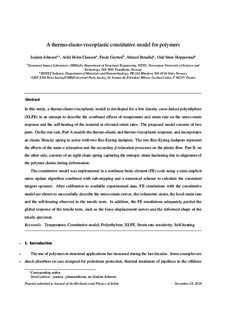| dc.contributor.author | Johnsen, Joakim | |
| dc.contributor.author | Clausen, Arild Holm | |
| dc.contributor.author | Grytten, Frode | |
| dc.contributor.author | Benallal, Ahmed | |
| dc.contributor.author | Hopperstad, Odd Sture | |
| dc.date.accessioned | 2018-12-12T15:48:20Z | |
| dc.date.available | 2018-12-12T15:48:20Z | |
| dc.date.created | 2018-11-29T12:22:38Z | |
| dc.date.issued | 2018 | |
| dc.identifier.issn | 0022-5096 | |
| dc.identifier.uri | http://hdl.handle.net/11250/2577486 | |
| dc.description.abstract | In this study, a thermo-elasto-viscoplastic model is developed for a low density cross-linked polyethylene (XLPE) in an attempt to describe the combined effects of temperature and strain rate on the stress-strain response and the self-heating of the material at elevated strain rates. The proposed model consists of two parts. On the one side, Part A models the thermo-elastic and thermo-viscoplastic response, and incorporates an elastic Hencky spring in series with two Ree-Eyring dashpots. The two Ree-Eyring dashpots represent the effects of the main α relaxation and the secondary β relaxation processes on the plastic flow. Part B, on the other side, consists of an eight chain spring capturing the entropic strain hardening due to alignment of the polymer chains during deformation.
The constitutive model was implemented in a nonlinear finite element (FE) code using a semi-implicit stress update algorithm combined with sub-stepping and a numerical scheme to calculate the consistent tangent operator. After calibration to available experimental data, FE simulations with the constitutive model are shown to successfully describe the stress-strain curves, the volumetric strain, the local strain rate and the self-heating observed in the tensile tests. In addition, the FE simulations adequately predict the global response of the tensile tests, such as the force-displacement curves and the deformed shape of the tensile specimen. | nb_NO |
| dc.language.iso | eng | nb_NO |
| dc.publisher | Elsevier | nb_NO |
| dc.relation.uri | https://doi.org/10.1016/j.jmps.2018.11.018 | |
| dc.rights | Attribution-NonCommercial-NoDerivatives 4.0 Internasjonal | * |
| dc.rights.uri | http://creativecommons.org/licenses/by-nc-nd/4.0/deed.no | * |
| dc.title | A thermo-elasto-viscoplastic constitutive model for polymers | nb_NO |
| dc.type | Journal article | nb_NO |
| dc.type | Peer reviewed | nb_NO |
| dc.description.version | acceptedVersion | nb_NO |
| dc.source.journal | Journal of the mechanics and physics of solids | nb_NO |
| dc.identifier.doi | 10.1016/j.jmps.2018.11.018 | |
| dc.identifier.cristin | 1636894 | |
| dc.relation.project | Norges forskningsråd: 228513 | nb_NO |
| dc.description.localcode | © 2018. This is the authors’ accepted and refereed manuscript to the article. Locked until 29.11.2020 due to copyright restrictions. This manuscript version is made available under the CC-BY-NC-ND 4.0 license http://creativecommons.org/licenses/by-nc-nd/4.0/ | nb_NO |
| cristin.unitcode | 194,64,45,0 | |
| cristin.unitname | Institutt for konstruksjonsteknikk | |
| cristin.ispublished | true | |
| cristin.fulltext | postprint | |
| cristin.qualitycode | 2 | |

